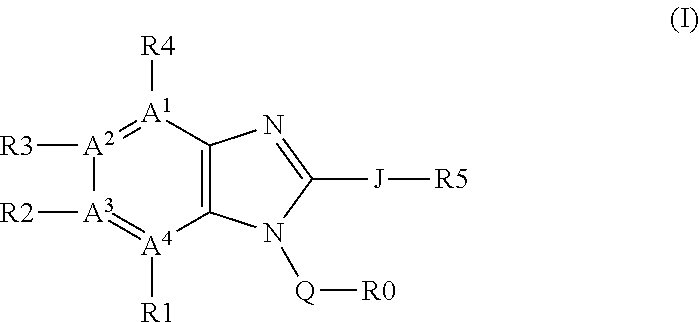Regioselective palladium catalyzed synthesis of benzimidazoles and azabenzimidazoles
a benzimidazole and azabenzimidazole technology, applied in the field of regioselective synthesis of compounds, can solve the problems of very time- and cost-effective processes, and achieve the effect of time- and cost-effectiveness
- Summary
- Abstract
- Description
- Claims
- Application Information
AI Technical Summary
Benefits of technology
Problems solved by technology
Method used
Image
Examples
example 1
5-Chloro-2-methyl-1-phenyl-1H-benzimidazole
[0175]
[0176]Method A: The 2,5-dichloronitrobenzene (96 mg, 0.5 mmol), N-phenyl-acetamide (81 mg, 0.6 mmol), palladium trifluoroacetate (13 mg, 0.04 mmol), BINAP (24 mg, 0.08 mmol) and cesium carbonate (212 mg, 0.7 mmol) were placed in a reaction tube, which was then purged with dry argon. Dry toluene (3 mL) was added, and the mixture was heated at 80° C. for 18 hours (h). The reaction was hydrolyzed with 3 mL of water and filtered through a Varian cartridge Chem Elut 12198007, rinsing with ethyl acetate. The crude was dissolved in 10 mL of glacial acetic acid and refluxed for 30 min in the presence of iron powder (279 mg, 5 mmol). The acid was removed under reduced pressure and the residue was suspended in saturated sodium bicarbonate solution and extracted with ethyl acetate. The obtained crude was purified by preparative HPLC, affording the title compound as a yellow solid (114 mg, 94% yield). mp 109-111° C. 1H NMR (DMSO) δ 2.52 (s, 3H), ...
example 2
2-Methyl-1-phenyl-1H-benzimidazole
[0179]
[0180]Method A afforded the title compound from 2-chloronitrobenzene (79 mg, 0.5 mmol) and N-phenyl-acetamide (81 mg, 0.6 mmol) as a yellow solid (82 mg, 78% yield). mp 46-48° C. 1H NMR δ 2.63 (m, 3H), 7.32 (d, J=Hz, 1H), 7.47 (t, J=Hz, 1H), 7.53 (t, J=Hz, 1H), 7.66-7.72 (m, 5H), 7.88 (d, J=7.2Hz, 2H); 13C NMR δ 12.6, 111.8, 115.1, 125.3, 127.1, 130.2, 130.3, 132.9, 133.8, 152.2, 158.3. HRMS (FAB): cal. for C14H13N2 [M+H+]: 209.1079; found: 209.1072. The same product was obtained from 2-bromonitrobenzene (101 mg, 0.5 mmol) in 80% yield (83 mg), and from 2-iodonitrobenzene (125 mg, 0.5 mmol) in 81% yield (84 mg).
[0181]Method C afforded 83 mg the title compound (80% yield).
example 3
7-Chloro-2-methyl-1-phenyl-1H-benzimidazole
[0182]
[0183]Method A applied to 2,3-dichloronitrobenzene (96 mg, 0.5 mmol) and N-phenylacetamide (81 mg, 0.6 mmol) yielded the title compound as a brown solid (81 mg, 67%). mp 103-105° C. 1H NMR (DMSO) δ 2.38 (s, 3H), 7.30-7-33 (m, 2H), 7.56-7.62 (m, 5H), 7.70 (dd, J=5.4, 3.7Hz, 1H); 13C NMR δ 13.2, 115.9, 116.0, 124.5, 125.0, 128.7, 129.3, 130.2, 134.6, 138.9, 153.7, 158.5. HRMS (FAB): cal. for C14H12N2Cl [M+H+]: 243.0689; found: 243.0683.
PUM
| Property | Measurement | Unit |
|---|---|---|
| temperature | aaaaa | aaaaa |
| temperature | aaaaa | aaaaa |
| temperature | aaaaa | aaaaa |
Abstract
Description
Claims
Application Information
 Login to View More
Login to View More - R&D
- Intellectual Property
- Life Sciences
- Materials
- Tech Scout
- Unparalleled Data Quality
- Higher Quality Content
- 60% Fewer Hallucinations
Browse by: Latest US Patents, China's latest patents, Technical Efficacy Thesaurus, Application Domain, Technology Topic, Popular Technical Reports.
© 2025 PatSnap. All rights reserved.Legal|Privacy policy|Modern Slavery Act Transparency Statement|Sitemap|About US| Contact US: help@patsnap.com



